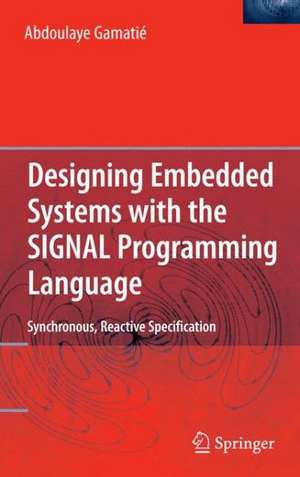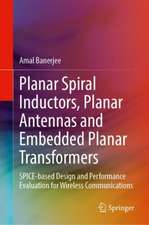Designing Embedded Systems with the SIGNAL Programming Language: Synchronous, Reactive Specification
Autor Abdoulaye Gamatiéen Limba Engleză Paperback – 26 noi 2014
| Toate formatele și edițiile | Preț | Express |
|---|---|---|
| Paperback (1) | 696.18 lei 6-8 săpt. | |
| Springer – 26 noi 2014 | 696.18 lei 6-8 săpt. | |
| Hardback (1) | 950.03 lei 6-8 săpt. | |
| Springer – 16 oct 2009 | 950.03 lei 6-8 săpt. |
Preț: 696.18 lei
Preț vechi: 819.03 lei
-15% Nou
Puncte Express: 1044
Preț estimativ în valută:
133.21€ • 139.48$ • 110.49£
133.21€ • 139.48$ • 110.49£
Carte tipărită la comandă
Livrare economică 09-23 aprilie
Preluare comenzi: 021 569.72.76
Specificații
ISBN-13: 9781489985125
ISBN-10: 1489985123
Pagini: 284
Ilustrații: XXIII, 259 p.
Dimensiuni: 155 x 235 x 15 mm
Greutate: 0.4 kg
Ediția:2010
Editura: Springer
Colecția Springer
Locul publicării:New York, NY, United States
ISBN-10: 1489985123
Pagini: 284
Ilustrații: XXIII, 259 p.
Dimensiuni: 155 x 235 x 15 mm
Greutate: 0.4 kg
Ediția:2010
Editura: Springer
Colecția Springer
Locul publicării:New York, NY, United States
Public țintă
ResearchCuprins
Real-time and synchronous programming.- Generalities on Real-Time Programming.- Synchronous Programming: Overview.- Elementary concepts and notations of SIGNAL.- Basics: Signals and Relations.- Programming Units: Processes.- Extended Constructs.- Design in P: First Steps.- Formal properties of SIGNAL programs.- Formal Semantics.- Formal Model for Program Analysis.- Compilation of Programs.- Advanced design in SIGNAL.- Advanced Design Concepts.- GALS System Design.- Design Patterns.- A Synchronization Example Design with P.
Textul de pe ultima copertă
This book is about synchronous programming for the design of, safety critical, embedded systems, such as automotive systems, avionics, nuclear power plants and telecommunication systems. The techniques presented promote the use of formal concepts, i.e. those having a mathematically sound basis. Such concepts enable non ambiguous and rigorous reasoning about the critical properties of addressed systems in order to ensure their reliability. The synchronous programming language, SIGNAL, is used to demonstrate the pragmatic design of embedded systems. This is an invaluable tutorial/reference for scientists, practitioners and students.
Among synchronous programming paradigms, Polychrony stands out for its ability to specify dataflow relationally, its freedom from single clock driven semantics, and its clock calculus that allows one to infer when single clock driven sequential software implementation is implied by the specification, and when refinements are required for such implementation. The SIGNAL language embodies Polychrony. There has been a void in the literature for a good single source which researchers can refer to, for learning the SIGNAL language, its semantics, and its usage.
Abdoulaye Gamatié has successfully used the SIGNAL language and the Polychrony toolset to implement realisticdesigns in the past. I believe that his book on the SIGNAL language will certainly be a very valuable resource for anyone interested in learning the SIGNAL language and its multi-clock semantics, and how to use it to specify and implement embedded software in a refinement methodology supported by extensive theory and tools developed at INRIA, Rennes.
----- Sandeep Shukla, Virginia Polytechnic and State University
- Presents the best pedagogical illustration of embedded system design with a synchronous dataflow programming language;
- Offers a complete overview of a language and its associated analysis techniques for the design of multi-clocked embedded systems;
- Describes a formal specification language that provides users with design and analysis tools to guarantee the reliability of safety-critical, embedded systems;
- Enables "correct-by-construction" designs for modern embedded systems, built on distributed architectures.
Among synchronous programming paradigms, Polychrony stands out for its ability to specify dataflow relationally, its freedom from single clock driven semantics, and its clock calculus that allows one to infer when single clock driven sequential software implementation is implied by the specification, and when refinements are required for such implementation. The SIGNAL language embodies Polychrony. There has been a void in the literature for a good single source which researchers can refer to, for learning the SIGNAL language, its semantics, and its usage.
Abdoulaye Gamatié has successfully used the SIGNAL language and the Polychrony toolset to implement realisticdesigns in the past. I believe that his book on the SIGNAL language will certainly be a very valuable resource for anyone interested in learning the SIGNAL language and its multi-clock semantics, and how to use it to specify and implement embedded software in a refinement methodology supported by extensive theory and tools developed at INRIA, Rennes.
----- Sandeep Shukla, Virginia Polytechnic and State University
Caracteristici
Presents the best pedagogical illustration of embedded system design with a synchronous programming language Offers a language and analysis techniques for the design of multi-clocked embedded systems Describes a formal specification language that provides users with design and analysis tools to guarantee the reliability of safety-critical, embedded systems Enables "correct-by-construction" designs for modern embedded systems, built on multiprocessor architectures Includes supplementary material: sn.pub/extras
























